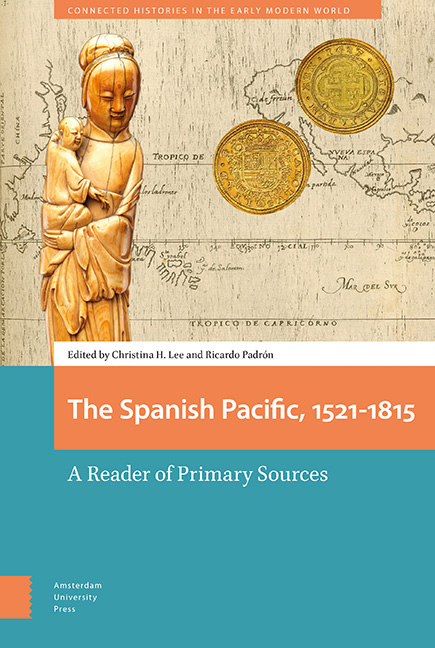Book contents
- Frontmatter
- Contents
- Abbreviations
- Acknowledgements
- Introduction
- 1 An Early Transpacific Account of the Spice Islands by Andrés de Urdaneta (1536)
- 2 Domingo de Salazar’s Letter to the King of Spain in Defense of the Indians and the Chinese of the Philippine Islands (1582)
- 3 Juan Cobo’s Map of the Pacific World (1593)
- 4 A Royal Decree of Philip III Regulating Trade between the Philippines and New Spain (1604)
- 5 Manila’s Sangleys and a Chinese Wedding (1625)
- 6 Don Luis Castilla Offers to Sell Land in Manila (1629)
- 7 Idolatry and Apostasy in the 1633 Jesuit Annual Letter
- 8 The Will of an Indian Oriental and her Chinos in Peru (1644
- 9 Francisco de Combés’s History of Mindanao and Jolo (1667)
- 10 Between Fiction and History in the Spanish Pacific The Misfortunes of Alonso Ramírez (1690)
- 11 A Moluccan Crypto-Muslim before the Transpacific Inquisition (1623–1645)
- 12 Constitutions and Rules of the Beatas Indias (1726)
- 13 The Poetics of Praise and the Demands of Confession in the Early Spanish Philippines: Notes and Documents
- 14 The Pacific Theater of the Seven Years’ War in a Latin Poem by an Indigenous Priest, Bartolomé Saguinsín (1766)
- 15 A Prohibition on Digging Up the Bones of the Dead (1813)
- Index
7 - Idolatry and Apostasy in the 1633 Jesuit Annual Letter
Published online by Cambridge University Press: 20 November 2020
- Frontmatter
- Contents
- Abbreviations
- Acknowledgements
- Introduction
- 1 An Early Transpacific Account of the Spice Islands by Andrés de Urdaneta (1536)
- 2 Domingo de Salazar’s Letter to the King of Spain in Defense of the Indians and the Chinese of the Philippine Islands (1582)
- 3 Juan Cobo’s Map of the Pacific World (1593)
- 4 A Royal Decree of Philip III Regulating Trade between the Philippines and New Spain (1604)
- 5 Manila’s Sangleys and a Chinese Wedding (1625)
- 6 Don Luis Castilla Offers to Sell Land in Manila (1629)
- 7 Idolatry and Apostasy in the 1633 Jesuit Annual Letter
- 8 The Will of an Indian Oriental and her Chinos in Peru (1644
- 9 Francisco de Combés’s History of Mindanao and Jolo (1667)
- 10 Between Fiction and History in the Spanish Pacific The Misfortunes of Alonso Ramírez (1690)
- 11 A Moluccan Crypto-Muslim before the Transpacific Inquisition (1623–1645)
- 12 Constitutions and Rules of the Beatas Indias (1726)
- 13 The Poetics of Praise and the Demands of Confession in the Early Spanish Philippines: Notes and Documents
- 14 The Pacific Theater of the Seven Years’ War in a Latin Poem by an Indigenous Priest, Bartolomé Saguinsín (1766)
- 15 A Prohibition on Digging Up the Bones of the Dead (1813)
- Index
Summary
Abstract
In this excerpt from the annual letter reporting on the state of the Jesuit order in the Philippines, Fr. Juan de Bueras, the Jesuit provincial, relates the difficulties that the Church was experiencing among the indigenous communities of the island of Mindoro. Hoping to convert the Magayanes people of the mountains to Christianity, the Jesuits found that they had to redirect their efforts to the supposedly Catholic communities of the coast, which had reverted to pre-Christian beliefs and practices. Bueras's letter provides insight into the limitations of the Church's effort to convert native Filipinos, and the nature of Filipino religious life in the early colonial context. John Blanco places the letter in the broader context of religious and secular colonialism, and broader questions about the supposed Hispanization of the Philippines.
Keywords: Society of Jesus; Jesuits; Hispanization; mission history; religion and colonialism
The following selection is excerpted from the 1633 Jesuit annual letter, written by the provincial head and procurator Fr. Juan de Bueras, to the superior general. These annual letters would serve as a general report on the status and plans of the missionary province in question, and oftentimes consisted of transcriptions from letters written by other Jesuits throughout the province and addressed to the provincial head. Seen in the wider context of colonial history and Philippine culture, however, the letter also obliges us to question our basic assumptions about religious conversion and native resistance on the transpacific frontier of the Spanish empire.
Father Bueras arrived in the archipelago in 1622, along with a number of Jesuits sent from Europe via the Mexico-Acapulco galleon for the purpose of expanding the Jesuit mission. The areas of Jesuit missionary activity included the island of Mindoro, just south of Luzon where the walled city of Intramuros lay on the banks of the Manila Bay. Prior to the Jesuits’ arrival in Nauhan, the settlement had been under the jurisdiction of the Archdiocese of Manila for fifty years. The primary purpose of the Jesuit mission in Mindoro was to preach to the native highland group known as Mangyanes, with the ultimate goal of converting them to Christianity and persuading them to be resettled or “reduced” (reducción) or “congregated” (congregación) around the coastal, presumably Christian, settlements.
- Type
- Chapter
- Information
- Spanish Pacific, 1521–1815A Reader of Primary Sources, pp. 115 - 130Publisher: Amsterdam University PressPrint publication year: 2020
- 1
- Cited by



